Japan
Wood Products Prices
Dollar Exchange Rates of 25th
Jun
2022
Japan Yen 135.55
Reports From Japan
Economy contracts but less than
expected
The Japanese economy contracted in the first quarter of
2022 but at a slower pace than estimated according to the
government. The economy contracted at an annual rate of
0.5% according to Cabinet Office data. Consumer
spending and other private demand was stronger than
anticipated but rising costs are expected to limit further
growth.
Japan imports all of its oil, much of its food and various
products and has been hit by rising prices for energy and
other commodities.
Bank of Japan Govovenor, Haruhiko Kuroda, has
championed a policy aimed at boosting near-zero inflation
to around 2% but progress was slow until global prices for
oil and other commodities surged in recent months.
See:
https://www.asahi.com/ajw/articles/14640207
Private sector concerned weak yen is hurting the
economy
Most major firms have voiced concern over the weak yen
saying this is hurting the country¡¯s economy. This was
expressed in a survey by the Asahi Shimbun and was a
response to the recent rapid depreciation of the yen which
has driven up import costs for raw materials and oil.
The yen was trading between 110 and 120 against the
dollar until mid-March. But the interest rate hike by the
US Federal Reserve Board sparked a sharp depreciation of
the yen. The yen fell to around 130 against the greenback
in April and hit 135 on 25 June.
Several executives interviewed questioned the Bank of
Japan¡¯s (BoJ) continuation of its monetary easing policy
as the economic environment continues to slide.
See:
https://www.asahi.com/ajw/articles/14649208
In related news the BoJ Governor has warned that the
yen's rapid depreciation is negative for the Japanese
economy, adding that volatile currency movements are
undesirable and should be stable reflecting economic and
financial fundamentals.
Kuroda said ¡°the recent rapid weakening of the yen
is
raising uncertainty over the outlook and making it hard for
companies to draw up business plans so it is negative and
undesirable for the economy".
See:
https://mainichi.jp/english/articles/20220617/p2g/00m/0bu/044000c

Rising cost of energy and daily necessities
dents
sentiment
The latest survey of consumer sentiment conducted for the
Cabinet Office shows sentiment declined in June driven
down mainly by the rising cost of energy and daily
necessities. Officials say the decline in corona virus cases
is helping to normalise economic activities and the
services sector is beginning to recover. More than 90% of
the survey respondents said they think prices will be
higher in a year's time.
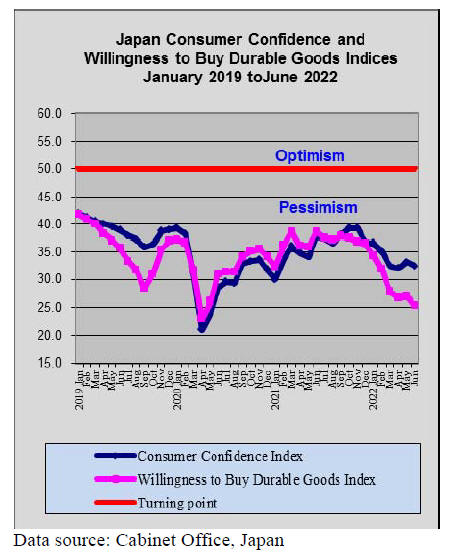
Performance of building materials trading
companies
There are four major trading companies for building
materials in Japan and they have recently released their
annual accounts which show increased income and profits
with some reporting record high profits. The rise in
income and profits has come mainly from higher prices for
structural sawnwood (prices tripled) and high plywood
sales prices.
It will be recalled from the previous report that
¡°profitability has become a major issue for house builders
because of the high and steadily rising costs of wood
products and other building materials. Builders anticipate
a tough year for profits in 2022¡±.
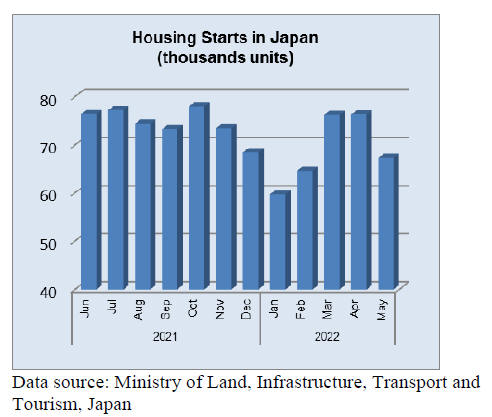
Import update
Assembled wooden flooring imports
The downward trend in the value of assembled wooden
flooring imports (HS441871-79) reported in March has
extended into April marking the forth consecutive monthly
decline. Even with the current downtrend the average
monthly value of assembled flooring imports in between
January and April 2022 are about the average for the past
three years.
Year on year, assembled wooden flooring imports in April
2022 were up slightly but the value of April imports was
down from March.
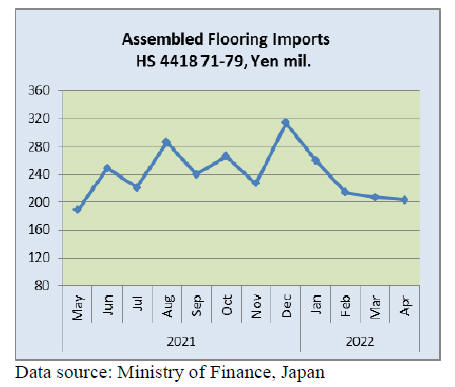
The main category of assembled flooring imported by
Japan continues to be HS441875 and this accounted for
69% of April 2022 imports with the main suppliers being
China and Vietnam. The value of imports of HS 441873
and HS 4441879 together accounted for just under 30% of
the value of assembled flooring imports in April.
Plywood imports
The volume of plywood imports in April this year were up
12% from a month earlier, the second month on month
rise.
Malaysia and Indonesia were the main plywood shippers
to Japan and in April this year shipments from Indonesia
fell slightly compared to the volume of March shipments,
on the other hand shipments to Japan from Malaysia
increased around 10%.
The major news in April was the doubling of plywood
imports from China. At 25,000 cu.m April shipments were
at a level not seen since 2014/15. The Japan Lumber
Reports has explained that imports of softwood plywood
from China have been climbing sharply in recent months.
Of the various categories of plywood imported in April
2022 (as in other months) HS441231 was the most
common accounting for almost 90% of total plywood
import volumes.
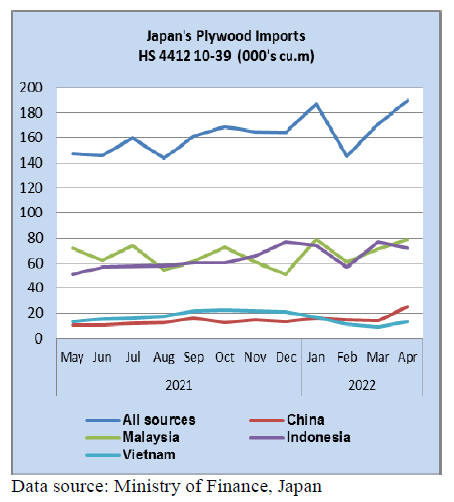
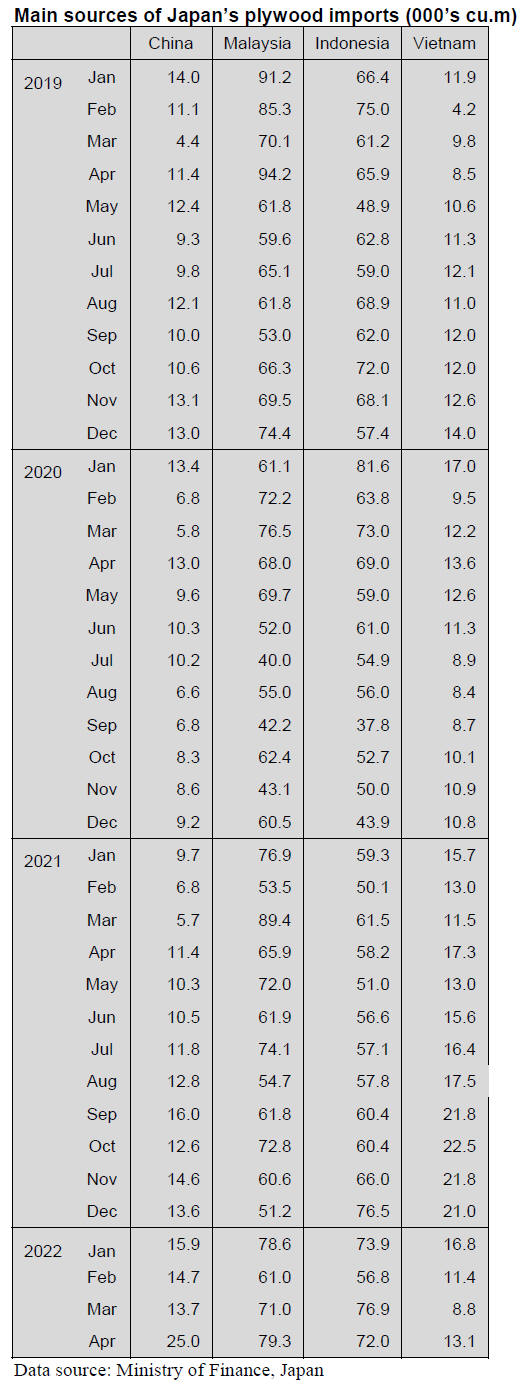
Trade news from the Japan Lumber Reports (JLR)
The Japan Lumber Reports (JLR), a subscription trade
journal published every two weeks in English, is
generously allowing the ITTO Tropical Timber Market
Report to reproduce news on the Japanese market
precisely as it appears in the JLR.
For the JLR report please see:
https://jfpj.jp/japan_lumber_reports/
Chinese made softwood plywood
Imports of softwood plywood from China has been
climbing sharply in recent months. April import is 11,800
cbms, 14 times more than April last year and doubled
March volume. This is because supply of domestic
softwood structural plywood has been chronically short so
high level import seems to continue for some time.
Import of Chinese softwood plywood in 2019 was 10,900
cbms so the import in April exceeded one year import of
2019. Since last summer, wholesalers started purchasing
Chinese products since the supply of domestic plywood
has priority to direct sales to precutting plants.
Chinese plywood mills see that tight supply of softwood
plywood Japan seems to continue so many try to acquire
JAS certificate and present high price of over 2,000 yen
per sheet is good enough to make profit. Also China can
buys Russian larch veneer, which is main material for the
Japanese plywood manufacturers then Russia stopped
exporting for Japan, so Chinese manufacturers have plenty
of raw materials.
However, there are criticism to use plywood with Russian
material among house builders in Japan. The prices of
Chinese plywood have gone up to 2,300 yen per sheet so
the dealers are becoming cautious in buying for future.
Housing starts in Japan may decline after summer and
once the demand weakens, import plywood is the first one
to be dumped and this would create confusion of plywood
market. Also there is some quality problem of Chinese
plywood such as uneven thickness.
Monthly import volume last year was less than 2,000 cbms
then since January, it increased sharply. January was 1,902
cbms, February was 3,975 cbms, March was 5,844 cbms
then April was 11,853 cbms. April volume was 3,267
cbms of 6 to 12 mm thick panel then 8,519 cbms of 12
mm or thicker panel
South Sea sawnwood and logs
Demand and supply of South Sea logs are still low. The
rainy season in Sarawak, Malaysia and Papua New Guinea
has ended but there are not enough logs yet. Usually, there
are many logs in this season. The reasons are a shortage of
workers due to COVID-19 and a confusion of distribution
system.The logs for Japan will be a tight supply but there
are enough logs in Japan because there is limited demand.
Some Japanese companies buy logs from Taiwan P.o.C
recently.
There are demand and supply at South Sea lumber and
Chinese lumber. Some products need to have the higher
prices due to a weak yen.
The prices of laminated lumber for any size from
Indonesia decreased in last month but in this month, it is
US$950 C&F per cbm. Some companies in Indonesia had
reduced the prices too much so they are regretting about it.
Then they are going to raise the prices again.
The prices of Chinese red pine lumber are US$1,020 ¨C
1,050 C&F per cbm. Chinese companies will not change
the prices due to active demand.
JAS certified lumber volume increased
The Japan Lumber Inspection and Research Association
disclosed that the volume of lumber certified JAS in 2021.
Total volume certified in 2021 is 1,088,251 cbms, 7.9% or
79,397 cbms more than 2020. This is slightly higher than
the result of 2018 when the volume was the highest of
1,086,452 cbms.
The volume of domestic lumber increased for four
consecutive years with 387,625 cbms, 3.6% more than
2020. Meantime, certified imported lumber was 700,626
cbms, 10.4% more than 2020, first increase in two years.
Share of imported lumber is 64.4% and domestic is 35.6%.
Number of JAS certified lumber is 301 out of total of 496.
Closing account of four major building materials
trading companies
There are four major trading companies of building
materials, Itochu Kenzai Corporation, Sojitz Building
Materials Corporation, Toyo Materia Corporation and
SMB Kenzai Co., Ltd. Their statement of accounts in
March 2022 are increased income and profits. Many
companies record high profit ever. This is because of the
wood shock caused by the COVID-19 in last year.
There had been a lot of housing demand in Europe and
North America and a lot of confusion at distribution
business. The prices of structural lumber increased double
to triple. Then, the prices of plywood jumped.
The total sales of these four companies are 901 billion yen,
20.7% more than last year. The recurring profit is 15.7
billion yen and the net income is 11 billion yen. This is 2.7
times increased from last year.
Itochu Kenzai records the highest sales, recurring
profit and net income ever. The company ranks in
1st place.
SMB Kenzai records the highest gross margin,
recurring profit and net income ever.
Sojitz Kenzai has a good result on recurring profit
and net income.
Toyo Materia records the highest profit ever.
|